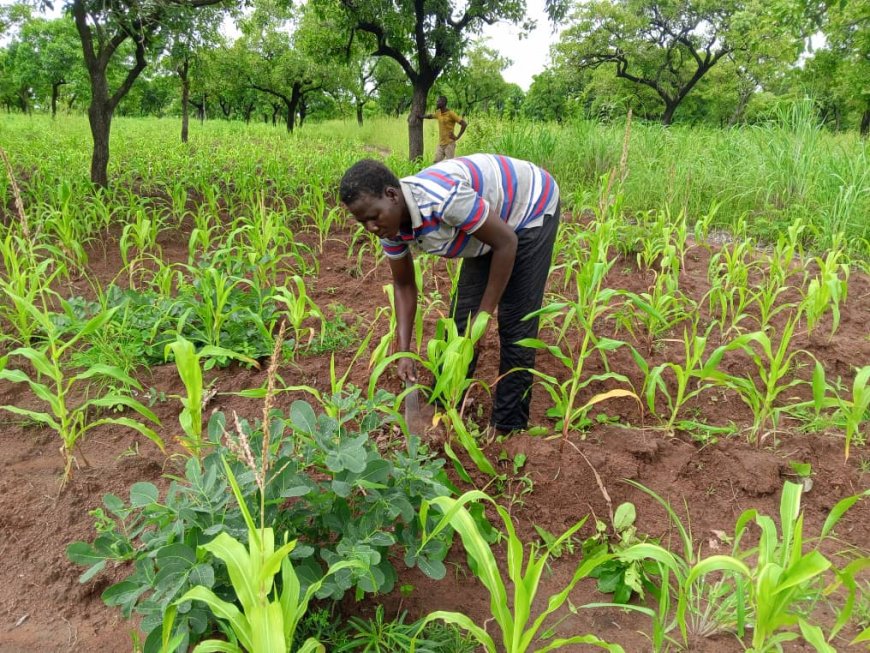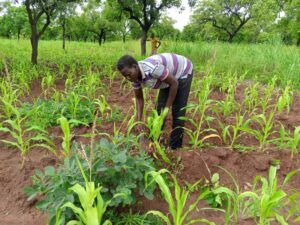Climate change effects female peasant farmers
Wrapped in a long sleeve over a pair of black trousers wielding a worn-out cutlass and a hoe, Madam Jackline Tanye, a peasant farmer at the Piree Community, reluctantly heads to her three-acre beans field, about 3km from her residence. The post Climate change effects female peasant farmers appeared first on Ghana Business News.



Wrapped in a long sleeve over a pair of black trousers wielding a worn-out cutlass and a hoe, Madam Jackline Tanye, a peasant farmer at the Piree Community, reluctantly heads to her three-acre beans field, about 3km from her residence.
With a gloomy face, an expression of disappointment and sadness, Madam Tanye, of about 45 years, was uncertain about how she and her family of three children would survive until the next planting season.
Apparently, her three-acre bean field had been destroyed by the nearly two months of drought that wreaked havoc in northern Ghana in July and August 2024, which destroyed several hectares of farms running into millions of Ghana cedis.
According to Madam Tanye, her worry was not just the destruction caused to the farm, but the money she invested in cultivating that farm, which yielded no positive results.
She told the Ghana News Agency (GNA) during a visit to her farm that she invested GH₵1,050.00 on that farm, quite a substantial amount for a rural peasant farmer like Madam Tanye.
Her hope was on the half an acre maize farm she had cultivated in her backyard, which showed no sign of producing good yield because she could not buy fertilizer to apply to the soil.
She also cultivated half an acre of beans farm after the rain resumed and hope to make a living from it if it did not suffer another drought.
The impact of the drought was not peculiar to Madam Jackline Tanye, Madam Matilda Dapaah, also a peasant farmer at Piree, suffered a similar fate after her one and half acres of groundnut farm was destroyed by the drought.
“My groundnut and beans farms have all been destroyed. They dried up because of the drought. My hope is on the maize, which could survive a little. The drought has really affected us”, Madam Dapaah told the GNA.
A visit to Madam Dapaah’s farm revealed that her two-acre maize farm was also severely affected by the drought resulting in stunted growth of the crops.
Several farmers in the Upper West Region faced the brunt of the drought spell occasioned by climate change.
According to Madam Sandra Lamptey, the Upper West Regional Crops Officer, the dry spell had destroyed 223,953 hectares of farms, including maize, rice, vegetables, and soybeans among others.
That affected a total of 115,012 farmers across the region, with 40,661 of them being women farmers, predominately peasant farmers.
The dry spell did not hit only the Upper West Region within the period, but seven other regions in the country were also affected, resulting in a severe impact on the agricultural sector of the nation’s economy.
Climate change impact
The debilitating impact had the potential to bring the planet to its knees, which made it the simple term with the greatest impact on lives.
The impact of climate change on humans extends from declining agricultural production and food security threats to the emergence of new diseases on humans and natural disasters such as floods and human rights among others
According to Antonio Guterres, the UN Secretary General, “The climate crisis is the biggest threat to our survival as a species and is already threatening human rights around the world.”
According to Dr. Iddrisu Yahaya, an Agricultural Economist with the Wa station of the Savanna Agricultural Research Institute of the Council for Scientific and Industrial Research (CSIR-SARI), climate change exerted a huge financial burden on farmers.
“Because of the drought as a result of climate change, farmers are going to lose approximately between 30 to 100 per cent of their crop.
“So, there is going to be economic loss to the farmers because they are going to lose their crops, which they have invested money in,” Dr. Yahaya explained.
Adaptation strategies
The term, “climate change” sounded abstract a few years back, but the realities are felt today, the most severe of them felt in the agricultural sector of the nation’s economy.
With the current circumstances in the Agricultural sector including erratic rainfall, prolonged drought and emergence of pests and disease among others, farmers need not to be told to adapt to the effects of climate change.
Stakeholders in the Agricultural sector had suggested several adaptation strategies to the effects of climate change.
One of such adaptation strategies was agroecology – a sustainable farming practice that works with nature.
Agroecology
Advocates of agro-ecology have described that practice as a potent means to adapt to the dire impact of the climate crisis on agricultural production.
Mr. Daniel Bauoku, the Deputy Director of the Centre for Indigenous Knowledge and Organisation (CIKOD) described agroecology as a bold solution to the impact of Climate Change.
“So, what agroecology does is that it provides the farmers a basket of agroecological solutions that are specific to agroecological zones.”
The net effects of climate change on farmers were erratic and uneven distribution of rain which resulted in drought and floods.
However, Mr. Bauoku said agroecological practices such as tied-ridging, cover-cropping, composting and bonding could reduce the impact of drought on agricultural production.
The adoption of such agro-ecological practices could help increase soil water retention and prevent surface run-off of water on the farms among others.
According to Dr. Kwaku Asante, a Research Scientist with the CSIR-Crop Research Institute (CRI), adopting agro-ecology would reduce the cost of production through reduced use of synthetic fertilizers and other chemicals for farming.
Practices such as cover cropping with leguminous crops like cowpeas and groundnuts fixed nitrogen to the soil and thereby reducing the demand for nitrogen-fixing synthetic fertilizers.
Dr. Alhassan Lansah Abdulai, Programmes Lead for Climate Change Response at the CSIR-SARI, Nyankpala, stressed that agro-ecology is a potent climate change adaptation strategy as its practices restored and created an ecology that can mimic the natural ecology.
FMNR as agro-ecology
One other agroecological practice that could be considered as both climate change adaptation and mitigation strategy was the Farmer-Managed Natural Regeneration of Trees (FMNR).
FMNR had been an age-old climate adaptation strategy for farmers, but its practice and benefits had probably not been appreciated by many farmers, especially commercial farmers.
The World Vision defined FMNR as a “systematic growth and management of trees and shrubs from felled tree stumps, sprouting root systems or seeds.”
Agro-ecology is a low-cost land restoration technique that could increase farmers’ resilience to climate extremes and enhance food production.
Mr. Banuoku observed that FMNR helped to create a microclimate, which helped reduce heat from the sun into the soil, enhance soil nutrients, reduce water evaporation from the soil and improve crop yield.
Other adaptation strategies
Aside from agro-ecology, Dr. Abdulai also suggested the adoption of climate-smart agricultural practices such as climate-resilient crop varieties as adaptation strategies for climate change.
He mentioned such strategies to include the adoption of extra-early and early maturing crop varieties as well as drought and flood-resistant crop varieties, which could withstand the effect of climate change.
The SDGs
The impact of climate change is a global crisis and has a negative correlation to attaining the United Nations Sustainable Development Goals (SDGs).
It could result in reduced agricultural production, retarding progress made in achieving Goal 1, which focused on ending poverty; Goal 2 on Achieving Zero hunger and SDG 5 on achieving gender equality by 2030.
Also, SDG 13 required state institutions to “Take urgent action to combat climate change and its impacts” with target 13.1 seeking to “Strengthen resilience and adaptive capacity to climate-related hazards and natural disasters in all countries”.
Recommendation
The effects of the climate crisis have made it urgent for consolidated local and global actions to reduce the effects of climate change by enhancing efforts towards climate change adaptation and mitigating strategies.
While it is necessary for the government to invest GHȻ8 billion into the agricultural sector including supporting drought-affected farmers, it is also crucial for the state to invest more resources in promoting agro-ecology among farmers as a long-term sustainable farming practice and climate change adaptation strategy.
Dr. Abdulai suggested the adoption of farming practices that reduced greenhouse gases, especially nitrous oxide emission into the atmosphere saying, “Nitrous oxide has a higher warming potential than carbon dioxide.”
He suggested proper fertilizer application (burring) and proper management of animal droppings and compost preparations as some ways of reducing greenhouse gas emissions.
He also recommended a policy that promotes the production and stocking of seeds of different maturity cycles for farmers to access when necessary.
On his part, Mr Justin Bayor, Head of Programmes, Campaigns and Innovations at ActionAid Ghana, suggested greater investment by the state and other key actors in agro-ecological farming methods such as dry season gardening.
He also recommended Indigenous climate-resilience seed development by research institutions in the country like the CSIR-SARI to enable farmers counter the effects of climate change.
By Philip Tengzu
Source: GNA
The post Climate change effects female peasant farmers appeared first on Ghana Business News.














































